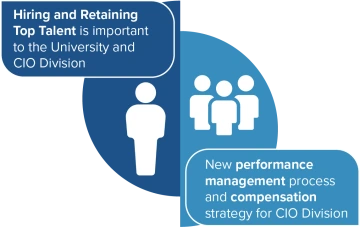RETAINING IT TALENT IN A GLOBAL ECONOMY
The CIO Division developed and completed a new performance management process that incorporates the University's Career Conversation model in conjunction with an expanded evaluation process based on three (or four for managers) Impact Factors.
The CIO Division HR team engaged with senior leadership teams on Impact Factors and Employee Ratings. After supervisors evaluated employees, the Division HR team conducted 15 calibration sessions to discuss performance expectations for each factor and ensure equitable assessments of the University Career Architecture Work Dimension guidelines across the department.

Expanded Evaluation Process
Impact Factors that correspond to the work dimensions outlined by the University Career Architecture Program.
Delivering Results
Getting the expected work done and demonstrating knowledge, skills, and abilities appropriate to job function and level.
Managing Self
Assuming responsibility, pursuing growth, and demonstrating flexibility, adaptation, and exploration.
Working with Others
Communicating and working effectively with others, promoting inclusivity, and approaching all that we do with integrity, compassion, and customer focus.
Setting Directions
Leading teams, strategies, or services effectively in relation to level expectations (people managers only).
Evaluation Process Results in an Overall Combined Rating
Exceeding Expectations: Frequently or consistently exceeds expectations for most/all behaviors.
Achieving Success: Consistently meets expectations for most/all behaviors.
Developing Contributions: Improvement needed in one or more behaviors to meet all expectations of the role.
Does Not Meet Expectations: Failed to meet expectations for many/most behaviors.
Results of FY21 CIO Division performance management and compensation strategy
Compensation Goals
- Recognize Best in Class Workforce
- Reward Good Performance
- Implement Market Changes
- Bring to Minimum Requirement
- Reduce Compression
- Implement Merit Increases Based on Performance
